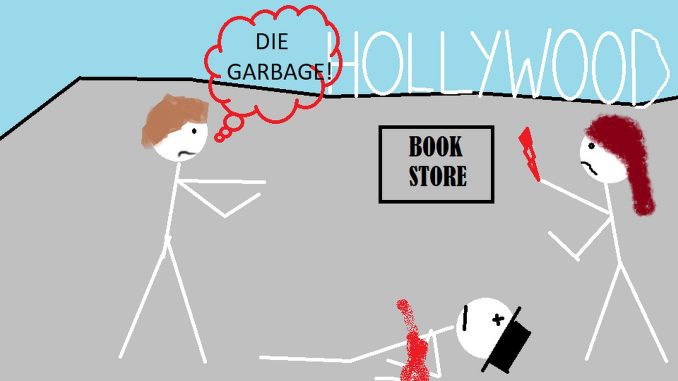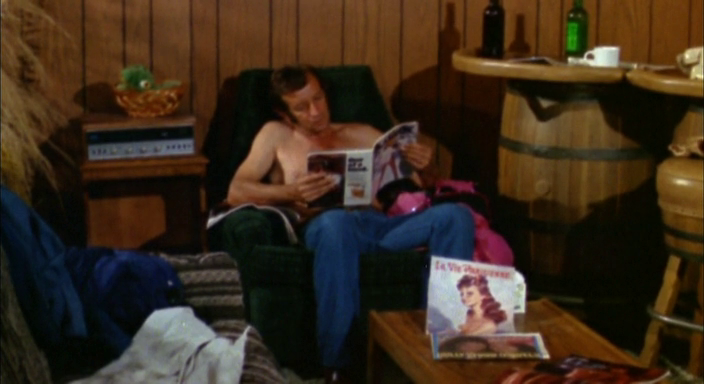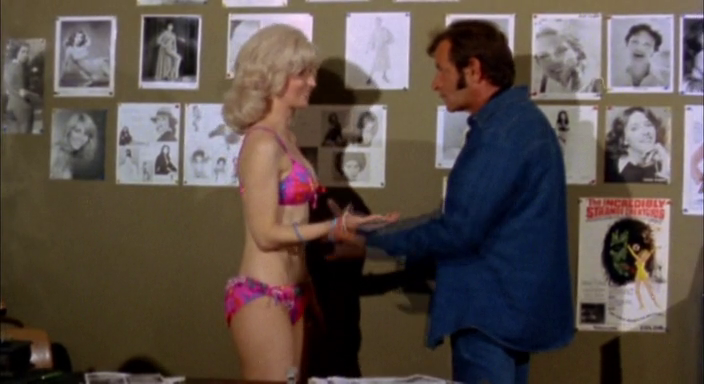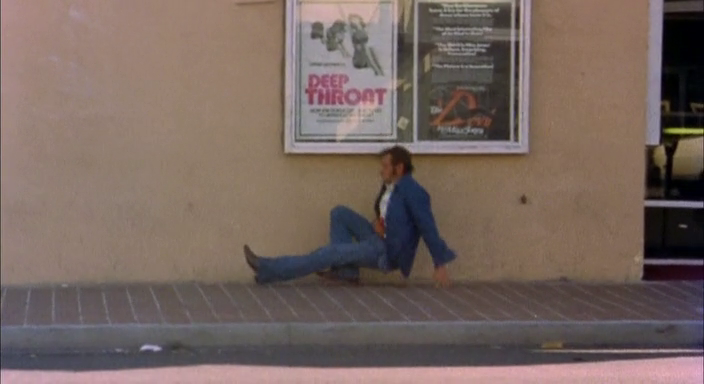
Rating: C
Dir: Ray Dennis Steckler
Star: Pierre Agostino, Carolyn Brandt
I was living out in West Hollywood
When a Hollywood strangler was strangling women.
Every night there was a panel discussion on TV about the strangler,
Speculations about his habits, his motives, his methods.
One thing was clear about him:
He only strangled women when they were alone, or with other women.
— The Hollywood Strangler by Laurie Anderson
Ray Dennis Steckler likely deserves induction into the Psychotronic Hall of Fame, for his work in the sixties, on films like Rat Pfink a Boo Boo and one of the most memorable titles in B-movie history, The Incredibly Strange Creatures Who Stopped Living and Became Mixed-Up Zombies [I’d like to thank that movie for its generous contribution towards me hitting my required word-count on this article]. Fun fact: he directed the music video for Jefferson Airplane’s White Rabbit, which like this, featured his then-wife Brandt.
By the late seventies, however, he had moved to Las Vegas and was largely churning out porn flicks such as Teenage Massage Parlor, under a variety of pseudonyms: Henri Pierre Duval, Cindy Lou Sutters, Sven Hellstrom or Ricardo Malatote. But at the end of the decade, he made a brief return to Los Angeles for this. It’s arguably a bit tasteless, because the city had recently been terrorized by an actual serial strangler – the one referenced by Laurie Anderson – who killed ten women in 1977-78. [It turned out to be two men, working in tandem: Kenneth Bianchi and Angelo Buono, the case being the explicit subject of several films, including 2004’s The Hillside Strangler]
Sound. It’s vastly over-rated. That certainly appears to be Steckler’s philosophy, and it’s clear that any dialogue was dubbed in afterwards. usually when the person concerned is not on the screen, or has their back to the camera, to avoid that pesky lip-synch thing. He’s certainly not alone in this in zero-budget cinema – Doris Wishman adopted a very similar approach. But Steckler also seems to lean heavily on his background in the smut industry. For we get the same deadpan (absence of) performance from his voice-over artist whether she is posing seductively, or being strangled. And there is a lot of both posing and strangling going on in this.
 The first half of the title is Johnathan Click (Agostino), though his name is never mentioned in the film. He’s a loner, who likes to lounge around his den with his top off (above), looking at girlie magazines. Then he calls up “photographer’s models,” goes round to visit them with his camera – which doesn’t contain any film – and strangles them. It’s largely because they don’t live up to his idealized concept of femininity, the much-mentioned but otherwise absent former love, Marsha. We hear a lot of his inner monologue – I suspect Steckler did the dubbing for the character himself – which is full of awkward pauses. The results sound as if the production got a volume discount on a bulk purchase of ellipsis, e.g. “She sounds anxious… Too anxious.. She’s… teasing me… Like Marsha used to tease me…”
The first half of the title is Johnathan Click (Agostino), though his name is never mentioned in the film. He’s a loner, who likes to lounge around his den with his top off (above), looking at girlie magazines. Then he calls up “photographer’s models,” goes round to visit them with his camera – which doesn’t contain any film – and strangles them. It’s largely because they don’t live up to his idealized concept of femininity, the much-mentioned but otherwise absent former love, Marsha. We hear a lot of his inner monologue – I suspect Steckler did the dubbing for the character himself – which is full of awkward pauses. The results sound as if the production got a volume discount on a bulk purchase of ellipsis, e.g. “She sounds anxious… Too anxious.. She’s… teasing me… Like Marsha used to tease me…”
Meanwhile, someone else is slicin’ and dicin’ the alky vagrants that hang around Hollywood Boulevard. All of whom are relatively well-dressed men in late middle-age, staggering around as they swig their alcoholic beverages out of paper-bags. [Though the resemblance of one to a tramp version of Jon Pertwee is somewhat amusing] Despite Steckler’s attempts to build suspense and hide the second killer’s identity, it’s not difficult to work out who the perpetrator is. Because apart from Johnathan, there’s only one person who appears in more than a single scene of this. It’s the unnamed owner of a used bookstore (Brandt), who has to deal with the vagrants breathing on her customers. She takes her animosity out on them in a sharp, pointy fashion, before going for a jog on the beach.
This actually is not a bad core idea: duelling serial killers. Especially when they operate on incompatible philosophies: one kills “garbage” women, the other is washing all the male scum off the streets. There are a number of interesting ways this could have gone. However, Steckler has no interest in any of them. Instead, all we got are repetitive sequences of the Strangler strangling and the Slasher slashing, without any escalation or real development. Occasionally, Johnathan will gaze at his colleague from afar, but it’s a very loose definition of in the title, since they never exchange a word. So, less “meets”, and more “stares at without saying anything”. Except, of course for Click’s vapid, ellipsis-filled internal droning: “This one’s different… Sensitive… Understanding…”
We probably reach peak “…” when Johnathan gets an unexpected two-for-one special, his latest “model” not being alone when he shows up with his camera. Fortunately, the dilemma is resolved because the blonde leaves the room to take a shower for no readily apparent reason. “Don’t wait… There’s no time… Do it… Not slow… Like Marsha… I’ve got… To do it…” For a touch of variety, he uses a scarf, and the blonde goes down under a pillow. Er, doesn’t that make him the Hollywood Suffocator? Though it appears this was only the case, so that Steckler got to use the woeful post-mayhem line, “Wonder if she saw that movie, Pillow Talk?”

Indeed, Click drifts even further away from his core ethos for the next one, drowning her in a hot tub, monologing tersely, “Quick… quick… Do it quick… Die, garbage!” [I’ve decided that Die Garbage is the name of my new German post-punk band.] Fortunately, before the movie needs retitling as The Hollywood Guy Who Kills People in a Variety of Ways, he gets back to basics, strangling his next victim in a parking lot. Though the thing that stood out here was the price to park. Ladies and gentlemen, this was a time when you could leave your car for up to twelve hours in Los Angeles at a cost of fifty cents.
That’s where this actually does work. Not a psychological drama, just as a time-capsule of a long gone and sleazy era. This was made the same year as Driller Killer, which captured a scummy side of New York, and does much the same for the opposite coast. A lot of this is just footage of people walking round Hollywood – I’m sure most of them have no clue the ended up in this film. Yet the historic value is great. It’s hard not to feel at least somewhat nostalgic about settings like the Flick O’Rama Arcade, advertising “Marital Aids – Color Film – Pinballs – 25c Movies”, or the entirely pointless scene in Plato’s Retreat, with roller-skating swingers. Though again, the most shocking element there is Johnathan smoking! Indoors! In California! Truly a bygone time.
Things meander on their expected conclusion, with few other surprises. Click visits a “model agency” where one of the photos on the wall is a poster for Incredibly Strange Creatures. Hohoho. Several lackluster killings later, and he finally confronts the Skid Row Slasher in the back-room of her shop. Where, for some reason, there’s bondage gear on the wall. And a coffin. As well as photos of the actress, which according to Steckler on the DVD commentary, were taken by Vilmos Zsigmond. If that name sounds familiar, it’s because he was the Oscar-winning cinematographer on Close Encounters of the Third Kind – and a camera operator on Incredibly Strange Creatures. Everyone starts somewhere, I guess.
Rather than comparing psychopathic notes, the Strangler and the Slasher engage in a savage, unrestrained fight to the death. It’s Freddy vs Jason! Alien vs. Predator! Godzilla vs… that three-headed lizard thing! [Ghidorah. That’s it.] Though actually, it’s not at all savage, and extremely restrained. Still, it ends with her dead and Johnathan squeezing out a final couple of ellipsis (“Marsha… Marsha…”), before collapsing at the door of a porno theater showing Deep Throat. Alberto Sarno warbles a cheerful and entirely inappropriate song, You’re My Love, over the end credits, though Click would apparently recover. For the character would return seven years later in another Steckler movie, Las Vegas Serial Killer.

Given this was made for a four-figure budget, it’s not too bad – at least, from a technical aspect and if you ignore the lack of dialogue. Steckler has a decent eye for composition, and his two leads have decent presence. Brandt, in particular, has the cold, dead eyes which either indicate a serial killer, or someone who has been in customer service for too long. The problem here is mostly a script that may well not have existed at all. It wouldn’t surprise me if there was little more than a napkin on which was written, “Guy strangles girls. Girl stabs guys. They have a fight.” For here, the high concept is the film, and even at a terse 71 minutes, comes close to outstaying its welcome.
